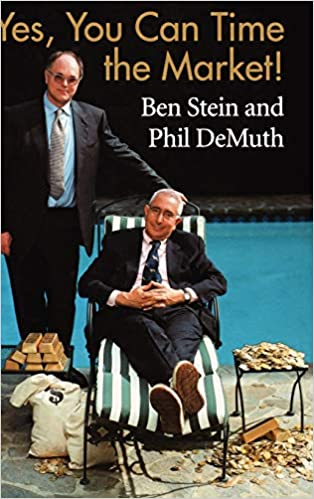originally posted elsewhere: September 8, 2003
tl;dr: Savvy advice that can make and preserve a fortune, long-term...
Stein and DeMuth succeed impressively in their primary aim, which is to prove that there are better times than others to invest in the stock market, and that a market timer who pays attention to the signals they describe can achieve significantly higher returns than a steady investor who buys in regardless of price. To determine whether the market is over- or under-priced, they rely upon valuation methods that will please the heart of a classically trained economist or business school student: price, P/E ratio, dividend rate, and price-to-book, comparing today's figures to the 15-year moving average. Examining the performance of the S&P 500 over the past century, they convincingly prove that a strategy of doubling up investments in "buy" (under-valued) years and avoiding investing in over-valued years delivers superior performance to a buy-and-hold (or dollar cost averaging) strategy.
Although what Stein and DeMuth have proven seems like common sense from one angle (buy heavily when prices are low), it is not what most of Wall Street and the financial press urges investors to do. Nor is it emotionally easy to follow this advice, since it means buying at times such as the middle of the Great Depression, when the popularity of stock market investing is at its lowest ebb, and it means avoiding buying when the market is zooming to the moon, and it seems as though every neighbor of yours is making a fortune in Internet and telecom stocks (the late Nineties). Stein and DeMuth do a great job describing these situations, to provide the internal fortitude needed to follow a buy low strategy.

The debate over this book arises over how applicable it is to the average individual investor (its target audience). All the research conducted by Stein and DeMuth concerns the S&P 500, and they freely admit that the conclusions they draw do not necessarily apply to other indices, markets, or individual stocks. Furthermore, they look at 20-year results, so the final verdicts for the last 20 years (including the bull market of the `90s) are not in yet.
However, Stein and DeMuth cite many others studies that are aligned with their general strategy of buying under-valued stocks, and summarize the superior results that these other studies report. Because of this, and the book's sharp wit and hard-hitting style, this book is a great introduction to value investing and the fundamental methods of valuing stocks. The boom and bust of the late Nineties and early 2000s prove that far too many investors (and professionals) don't pay enough attention to stock market valuation.
This book won't tell you how to make a quick fortune. It won't tell you how to identify the next Microsoft or Dell Computer. But it does tell you how to identify better times to invest in stocks, and can help you avoid huge losses from investing in bubbles. Because of the strength of the book's advice, which recent history proves is so often ignored, and the fact that it is a short and entertaining read, I highly recommend it.